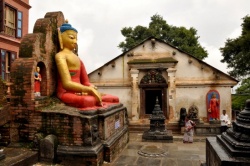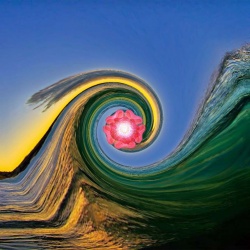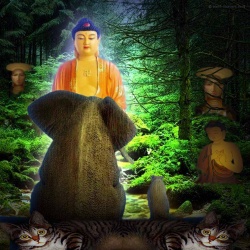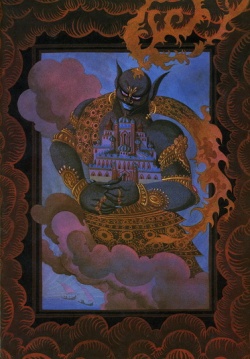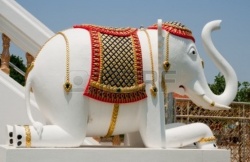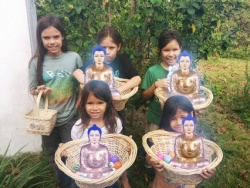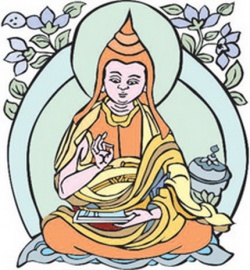The Khandhas
- The word khandha (Skr. skandha) means the trunk of a tree and is generally used to mean group or aggregate [Footnote ref 135]. We have seen that Buddha said that there was no atman (soul). He said that when people held that they found the much spoken of soul, they really only found the five khandhas together or any one of them.
The khandhas are aggregates of bodily and psychical states which are immediate with us and are divided into five classes:
(1) rupa (four elements, the body, the senses), sense data, etc.,
(2) vedana (feeling--pleasurable, painful and indifferent),
(3) sanna (conceptual knowledge),
(4) sankhara (synthetic mental states and the synthetic functioning of compound sense-affections, compound feelings and compound concepts),
(5) vinnana (consciousness) [Footnote ref 136].
All these states rise depending one upon the other (_paticcasamuppanna_) and when a man says that he perceives the self he only deludes himself, for he only perceives one or more of these. The word rupa in rupakhandha stands for matter and material qualities, the senses, and the sense data [Footnote ref 137].
But "rupa" is also used in the sense of pure organic affections or states of mind as we find in the _Khandha Yamaka_, I.p. 16, and also in _Samyutta Nikaya_, III. 86. Rupaskandha according to _Dharmasamgraha_ means the aggregate of five senses, the five sensations, and the implicatory communications associated in sense perceptions _vijnapti_).
The elaborate discussion of _Dhammasangani_ begins by defining rupa as "_cattaro ca mahabhuta catunnanca mahabhntanam upadaya rupam_" (the four mahabhutas or elements and that proceeding from the grasping of that is called rupa) [Footnote ref 138].
Buddhaghosa explains it by saying that rupa means the four mahabhutas and those which arise depending (_nissaya_) on them as a modification of them.
In the rupa the six senses including their affections are also included. In explaining why the four elements are called mahabhutas, Buddhaghosa says:
"Just as a magician (_mayakara_) makes the water which is not hard appear as hard, makes the stone which is not gold appear as gold;
just as he himself though not a ghost nor a bird makes himself appear as a ghost or a bird, so these elements though not themselves blue make themselves appear as blue (_nilam upada rupam_), not yellow, red, or white make themselves appear as yellow, red or white (odatam upadarupam),
so on account of their similarity to the appearances created by the magician they are called mahabhuta [Footnote ref 139]."
In the _Samyutta Nikaya_ we find that the Buddha says, "O Bhikkhus it is called rupam because it manifests (_rupyati_); howdoes it manifest?
It manifests as cold, and as heat, as hunger and as thirst, it manifests as the touch of gnats, mosquitos, wind, the sun and the snake; it manifests, therefore it is called rupa [Footnote ref 140]."
If we take the somewhat conflicting passages referred to above for our consideration and try to combine them so as to understand what is meant by rupa, I think we find that that which manifested itself to the senses and organs was called rupa.
No distinction seems to have been made between the sense-data as colours, smells, etc., as existing in the physical world and their appearance as sensations.
They were only numerically different and the appearance of the sensations was dependent upon the sense-data and the senses but the sense-data and the sensations were "rupa."
Under certain conditions the sense-data were followed by the sensations.
Buddhism did not probably start with the same kind of division of matter and mind as we now do.
And it may not be out of place to mention that such an opposition and duality were found neither in the Upanisads nor in the Samkhya system which is regarded by some as pre-Buddhistic.
The four elements manifested themselves in certain forms and were therefore called rupa; the forms of affection that appeared were also called rupa; many other mental states or features which appeared with them were also called rupa [Footnote ref 141].
The ayatanas or the senses were also called rupa [Footnote ref 142].
The mahabhutas or four elements were themselves but changing manifestations, and they together with all that appeared in association with them were called rupa and formed the rupa khandha (the classes of sense-materials, sense-data, senses and sensations).
In _Samyutta Nikaya_ (III. 101) it is said that "the four mahabhutas were the hetu and the paccaya for the communication of the rupakkhandha (_rupakkhandhassa pannapanaya_).
Contact (sense-contact, phassa) is the cause of the communication of feelings (_vedana_);
sense-contact was also the hetu and paccaya for the communication of the sannakkhandha;
sense-contact is also the hetu and paccaya for the communication of the sankharakkhandha.
But namarupa is the hetu and the paccaya for the communication of the vinnanakkhandha."
Thus not only feelings arise on account of the sense-contact but sanna and sankhara also arise therefrom.
Sanna is that where specific knowing orconceiving takes place. This is the stage where the specific distinctive knowledge as the yellow or the red takes place.
Mrs. Rhys Davids writing on sanna says:
"In editing the second book of the Abhidhamma pitaka I found a classification distinguishing between sanna as cognitive assimilation on occasion of sense, and sanna as cognitive assimilation of ideas by way of naming.
The former is called perception of resistance, or opposition (_patigha-sanna_).
This, writes Buddhaghosa, is perception on occasion of sight, hearing, etc., when consciousness is aware of the impact of impressions; of external things as different, we might say.
The latter is called perception of the equivalent word or name (_adhivachana-sanna_) and is exercised by the _sensus communis_ (mano), when e.g. 'one is seated...and asks another who is thoughtful: "What are you thinking of?" one perceives through his speech.'
Thus there are two stages of sanna-consciousness,
1. contemplating sense-impressions,
2. ability to know what they are by naming [Footnote ref 143]."
About sankhara we read in _Samyutta Nikaya_ (III. 87) that it is called sankhara because it synthesises (_abhisankharonti_), it is that which conglomerated rupa as rupa, conglomerated sanna as sanna, sankhara as sankhara and consciousness (_vinnana_) as consciousness.
It is called sankhara because it synthesises the conglomerated (_sankhatam abhisankharonti_).
It is thus a synthetic function which synthesises the passive rupa, sanna, sankhara and vinnana elements.
The fact that we hear of 52 sankhara states and also that the sankhara exercises its synthetic activity on the conglomerated elements in it, goes to show that probably the word sankhara is used in two senses, as mental states and as synthetic activity.
Vinnana or consciousness meant according to Buddhaghosa, as we have already seen in the previous section, both the stage at which the intellectual process started and also the final resulting consciousness.
Buddhaghosa in explaining the process of Buddhist psychology says that "consciousness(_citta_)first comes into touch (_phassa_) with its object (_arammana_) and thereafter feeling, conception (_sanna_) and volition (_cetana_) come in.
This contact is like the pillars of a palace, and the rest are but the superstructure built upon it (_dabbasambharasadisa_).
But it should not be thought that contactis the beginning of the psychological processes, for in one whole consciousness (_ekacittasmim_) it cannot be said that this comes first and that comes after, so we can take contact in association with feeling (_vedana_), conceiving (_sanna_) or volition (_cetana_); it is itself an immaterial state but yet since it comprehends objects it is called contact."
"There is no impinging on one side of the object (as in physical contact), nevertheless contact causes consciousness and object to be in collision, as visible object and visual organs, sound and hearing;
thus impact is its _function_; or it has impact as its _essential property_ in the sense of attainment, owing to the impact of the physical basis with the mental object.
For it is said in the Commentary:--"contact in the four planes of existence is never without the characteristic of touch with the object; but the function of impact takes place in the five doors.
For to sense, or five-door contact, is given the name 'having the characteristic of touch' as well as 'having the function of impact.'
But to contact in the mind-door there is only the characteristic of touch, but not the function of impact.
And then this Sutta is quoted 'As if, sire, two rams were to fight, one ram to represent the eye, the second the visible object, and their collision contact.
And as if, sire, two cymbals were to strike against each other, or two hands were to clap against each other; one hand would represent the eye, the second the visible object and their collision contact.
Thus contact has the characteristic of touch and the function of impact [Footnote ref 144]'.
Contact is the manifestation of the union of the three (the object, the consciousness and the sense) and its effect is feeling (_vedana_); though it is generated by the objects it is felt in the consciousness and its chief feature is experiencing (_anubhava_) the taste of the object.
As regards enjoying the taste of an object, the remaining associated states enjoy it only partially.
Of contact there is (the function of) the mere touching, of perception the mere noting or perceiving, of volition the mere coordinating, of consciousness the mere cognizing.
But feeling alone, through governance, proficiency, mastery, enjoys the taste of an object.
For feeling is like the king, the remaining states are like the cook.
As the cook, when he has prepared food of diverse tastes, puts it in a basket, seals it, takes it to the king, breaks the seal, opens the basket, takes the best of all the soup and curries, puts them in a dish,
swallows (a portion) to find outwhether they are faulty or not and afterwards offers the food of various excellent tastes to the king, and the king, being lord, expert,
and master, eats whatever he likes, even so the mere tasting of the food by the cook is like the partial enjoyment of the object by the remaining states, and as the cook tastes a portion of the food, so the remaining states enjoy a portion of the object, and as the king, being lord, expert and master,
eats the meal according to his pleasure so feeling being lord expert, and master, enjoys the taste of the object and therefore it is said that enjoyment or experience is its function [Footnote ref 145]."
The special feature of sanna is said to be the recognizing (_paccabhinna_) by means of a sign (_abhinnanena_). According to another explanation, a recognition takes place by the inclusion of the totality (of aspects)--_sabbasangahikavasena_. The work of volition (_cetana_) is said to be coordination or binding together (_abhisandahana_).
"Volition is exceedingly energetic and makes a double effort, a double exertion.
Hence the Ancients said 'Volition is like the nature of a landowner, a cultivator who taking fifty-five strong men, went down to the fields to reap.
He was exceedingly energetic and exceedingly strenuous; he doubled his strength and said
"Take your sickles" and so forth, pointed out the portion to be reaped, offered them drink, food, scent, flowers, etc., and took an equal share of the work.'
The simile should be thus applied: volition is like the cultivator, the fifty-five moral states which arise as factors of consciousness are like the fifty-five strong men;
like the time of doubling strength, doubling effort by the cultivator is the doubled strength, doubled effort of volition as regards activity in moral and immoral acts [Footnote ref 146]."
It seems that probably the active side operating in sankhara was separately designated as cetana (volition).
"When one says 'I,' what he does is that he refers either to all the khandhas combined or any one of them and deludes himself that that was 'I.
' Just as one could not say that the fragrance of the lotus belonged to the petals, the colour or the pollen, so one could not say that the rupa was 'I' or that the vedana was 'I' or any of the other khandhas was 'I.'
There is nowhere to be found in the khandhas 'I am [Footnote ref 147]'."
